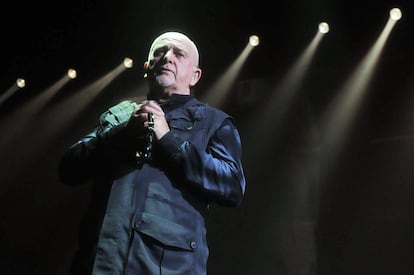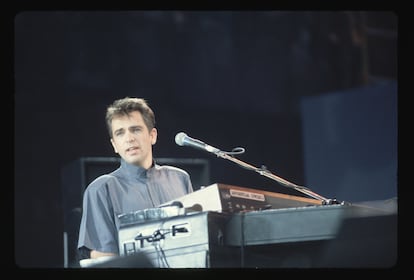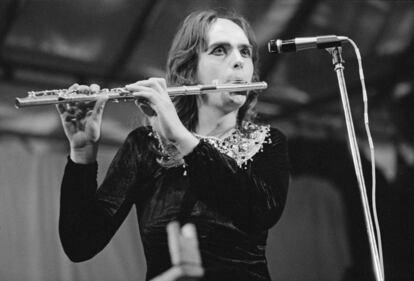Peter Gabriel’s spiraling obsession: 21 years to come up with 12 songs
The British musician amazes with ‘i/o,’ his comeback album, but no one can figure out why it took him more than two decades to complete it

It was one of the most relevant music news of the end of 2023, of that there is no doubt. A new album by Peter Gabriel, with a title as succinct and peculiar as we have come to expect from him: i/o. No one denies its superb quality. However, a question underlies the headlines — or rather, a puzzlement, for the millions of followers of the man who was the leader of the exceptional Genesis until 1975, and the creator, during the 1980s, of great hits such as Shock the Monkey, Don’t Give Up and Sledgehammer. There is no human way to explain why it took this man 21 years to complete a new album, a process so obsessive and meticulous that it surely has no parallel in the entire history of popular music.
In fact, the number could be even higher: the credits explain that the album includes “drafts” that came into existence as far back as 1995. What is true is that Gabriel picks up his soloist rhetoric (calmed, lyrical, detailed, polyrhythmic and complicit in spirit with ethnic music) right where he left off in his previous original album, Up, in 2002. And, aside from whatever unspoken reproaches there may be for his tardiness, there is a broad consensus regarding the excellence of these dozen compositions.
The Metacritic website, which compiles and evaluates reviews from the main media outlets, gives it a very high average score (87 out of 100), with enthusiastic reviews from the British newspapers The Telegraph, The Observer and The Independent. i/o (apparently an abbreviation of the terms in and out, or input and output) has already reached the first place in the sales charts of the United Kingdom, Canada and Belgium, as well as number 2 in Germany and number 7 in the United States. But the million-dollar question remains unanswered: why invest an eternity in an album that follows in the wake of previous works? Because it does maintain same line of the last thirty-odd years, with David Rhodes’ guitar and the rhythmic base in which bassist Tony Levin and drummer Manu Katché interact.

At 73 years old, Peter Gabriel, who is also the founder of the Real World record label and the Womad world music festival, gave something akin to an apology in the presentation of i/o, boasting that each of the 12 songs has inspired works of pictorial art, too. Gabriel’s meticulous nature has become more acute over the years, but this is nothing new. He spoke honestly about it in an interview for Melody Maker magazine in the late 1980s, where he talked about how details slow him down; turning ideas into songs, he explained, simply takes him a disproportionate amount of time. He starts with perhaps 40 or 50 concepts, which then have to be boiled down to 10 or 12 songs.
Of course, that interview took place back when Gabriel used to appear in record stores every two years. That was the case of his first four solo albums, for which he did not invest any time in finding titles: all of them featured only his name on the cover, all with identical typography. Those statements from 43 years ago are collected by the Spanish historian and music critic Javier de Diego Romero in his exhaustive book Peter Gabriel: Un explorador musical y su tiempo (Peter Gabriel: A musical explorer and his time), his first biography in Spanish, which will be published in March. After consulting hundreds of sources and articles, De Diego confirms that this obsession with detail has only gotten worse over the years. When he published Up in 2002 and journalists bombarded him with questions about the ten years that had passed since his previous work (Us, 1992), he replied that he enjoys generating new ideas so much that he does not feel the need to finish anything. When creating, he explained, he starts from the periphery and tries to find the center by going in spirals.
Indeed, pragmatism does not seem to be the greatest of his virtues. His Spanish biographer recalls that recordings for i/o began “intensely” in 2005, as soon as he was done with his Still Growing Up tour. By then, he had already confirmed in interviews with Mojo and Rolling Stone what the short, strange title of the album would be. Around 2008 he revealed in La Presse that he already had “some 60 songs,” but was already showing signs that he was in no rush. “It will come out when it’s ready. Besides, music is not everything in life. I just became a father to a child, I want to spend time with him.” The warning signs became more evident after 2010 when he explained, again to the British magazine Mojo, that while in his youth he used to work about 100 hours a week, he now took the weekends off, and during the week he divided his time between music, charity activities and technological projects.
Thirteen years have passed since those statements, without Peter Brian Gabriel bothering to step on the gas. Undisturbed, he even had the gall to tackle a cover album (Scratch My Back, 2010), one with orchestral arrangements for his most emblematic titles (New Blood, 2011) and an unusual tour with Sting, in 2016, in which both alternated and exchanged their flagship songs. Many digressions, alternative projects and derivatives, but not a word about the completion of an album that was slowly turning into a mirage.

The lack of urgency displayed throughout the entire process is even more surprising if we consider the pressures inherent to age. His attitude contrasts with the frenetic activity of other sacred cows such as Van Morrison or Neil Young, both 78 years old, who have been delivering two, three, and up to four new works per season. Bob Dylan, 82, the greatest guru of the old guard, is not as prolific in terms of new material, but he remains immersed in his aptly named Neverending Tour, and he keeps authorizing dozens of releases drawn from his colossal archives.
Faced with such frenzy, Gabriel opted to further slow down the final materialization of i/o with the unusual decision of commissioning two different final mixes... to end up releasing both. Because this new album can be enjoyed in two different versions: Mark Spike Tent is responsible for the one known as the Bright-Side Mix, while Tchad Blake is behind the Dark-Side Mix. The differences are quite subtle, but fans can amuse themselves by comparing the sound of both. According to Gabriel, Tchad is like a sculptor who builds from drama, while Spike works like a painter, collecting images.
Was it worth all the effort to end up creating an outstanding album, yes, but not all that different from So (1986), Us (1992) and Up (2002)? Surely only Peter Brian Gabriel understands the need for such a labyrinthine, tortuous process, but the album’s succession of songs itself, from Love Can Heal to Road to Joy, This Is Home or Live and Let Live, reveals him as a sensible creator, analytical and critical of the world around him, but inevitably optimistic. And he can always look around and claim that in 2023, the Rolling Stones themselves ended 18 years of drought with Hackney Diamonds.
Still, he is not the laziest musician we can think of. When Paul Rodgers, leader of the bands Free and Bad Company in the 1970s, released his Midnight Rose in September 2023, we realized that its predecessor, Electric, was actually from the last century (1999). So, strictly speaking, Peter Gabriel and his i/o cannot claim the title of the laziest singers in the history of pop.
Sign up for our weekly newsletter to get more English-language news coverage from EL PAÍS USA Edition
Tu suscripción se está usando en otro dispositivo
¿Quieres añadir otro usuario a tu suscripción?
Si continúas leyendo en este dispositivo, no se podrá leer en el otro.
FlechaTu suscripción se está usando en otro dispositivo y solo puedes acceder a EL PAÍS desde un dispositivo a la vez.
Si quieres compartir tu cuenta, cambia tu suscripción a la modalidad Premium, así podrás añadir otro usuario. Cada uno accederá con su propia cuenta de email, lo que os permitirá personalizar vuestra experiencia en EL PAÍS.
¿Tienes una suscripción de empresa? Accede aquí para contratar más cuentas.
En el caso de no saber quién está usando tu cuenta, te recomendamos cambiar tu contraseña aquí.
Si decides continuar compartiendo tu cuenta, este mensaje se mostrará en tu dispositivo y en el de la otra persona que está usando tu cuenta de forma indefinida, afectando a tu experiencia de lectura. Puedes consultar aquí los términos y condiciones de la suscripción digital.
More information
Archived In
Últimas noticias
Most viewed
- Reinhard Genzel, Nobel laureate in physics: ‘One-minute videos will never give you the truth’
- Oona Chaplin: ‘I told James Cameron that I was living in a treehouse and starting a permaculture project with a friend’
- Pablo Escobar’s hippos: A serious environmental problem, 40 years on
- Chevy Chase, the beloved comedian who was a monster off camera: ‘Not everyone hated him, just the people who’ve worked with him’
- Why we lost the habit of sleeping in two segments and how that changed our sense of time











































